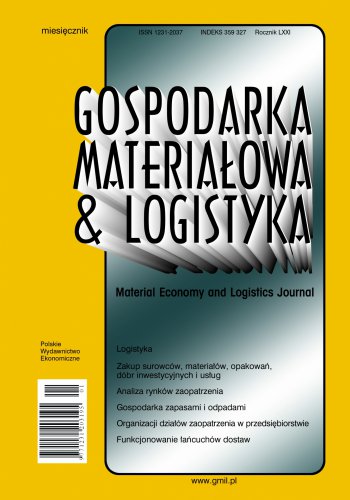Resource intensity in industry — an example of coke intensity in Polish steel industry
The publication presents the analysis of the coke intensity for the Polish steel sector using descriptive statistics. The resource intensity is one of the important measures for assessing the sustainability of the economy, industry and enterprises. Coke is the basic material (resource) used in metallurgy for the production of steel. Coke intensity in the steel industry is a measure of the processing and coke intensity (consumption) by integrated steel mills, i.e. ones equipped with installations of blast furnaces and converters. The article presents an analysis of the coke consumption in the steel production process in Poland. Coking plants in Poland offer steel coke, foundry coke, heating coke and export coke (this explanation is important for understanding the scope of the analysis). This paper presents the coke oven market in Poland (historical changes) together with the coke production volume in 1995–2019. Then, comparisons were made of the coke production volume with the pig iron production and the production of steel produced in the BF + BOF technology (short for Blast Furnace + Basic Oxygen Furnace). The performed analysis may be useful in assessing the impact of the coke and steel industry on the sustainability of the economy in the area of resource consumption, on the example of coke production. The added value of the article is a long-term historical presentation of coke intensity. The analysis was based on industry data presented annually for the past 25 years. The aim of the research (analysis) was to fix the level of coke intensity in the market relation: supplier and producer.
References
Bibliografia/References
Blaik, P. (2001). Logistyka. Warszawa: PWN.
Bendkowski, J., Radziejowska, G. (2011). Logistyka zaopatrzenia w przedsiębiorstwie. Gliwice: Wydawnictwo Politechniki Śląskiej.
Coyle, J. J., Bardi E. J., Langley Jr., C. J. (2002). Zarządzanie logistyczne. Warszawa: Polskie Wydawnictwo Ekonomiczne.
Dueck, O., Schoetz, S. (2003). Gospodarka materiałowa. Poradnik praktyczny. Warszawa: Wydawnictwo ALFA-WEKA.
Dzienniak, S. (2020a). Zużycie mediów energetycznych w hutnictwie. Katowice: Hutnicza Izba Przemysłowo-Handlowa (HIPH).
Dzienniak, S. (2020b). Droga energia przyczyną niskiej konkurencyjności polskiej gospodarki na przykładzie przemysłu stalowego. Prezentacja na konferencji PTE pt. Ekonomiczne skutki pandemii. Katowice, 22.09.2020.
Fertsch, M. (red.) (2003). Logistyka produkcji. Poznań: Wydawnictwo Instytutu Logistyki i Magazynowania.
Gajdzik, B. (2015a). Odpowiedzialny wybór dostawców z zarządzaniu zaopatrzeniem w przedsiębiorstwie hutniczym. Prace Instytutu Metalurgii Żelaza w Gliwicach, 67(3), 42–49.
Gajdzik, B. (2015b). Samoocena dostawców w odpowiedzialnym pozyskiwaniu zasobów. Organizacja i Zarządzanie. Kwartalnik Naukowy Politechniki Śląskiej, 3931, 57–78.
Gajdzik, B., Zagórska, M. (2020). Analiza stalochłonności polskiej gospodarki przy użyciu wybranych mierników. Gospodarka Materiałowa i Logistyka, (6), 19–25. https://doi.org/10.33226/1231-2037.2020.6.3
Horbal, R. (2008). Partnerska współpraca. Top Logistyk, (6). Hutnicza Izba Przemysłowo-Handlowa (2020). Polski przemysł stalowy. Katowice.
Hutnicza Izba Przemysłowo-Handlowa, Raporty roczne z lat 2003–2020, Katowice.
Kiel, D. Müller, J. M., Arnold, Ch. (2017). Sustainable Industrial Value Creation: Benefits and Challenges of Industry 4.0. International Journal of Innovation Management, 21(8), 1–34. https://doi.org/10.1142/S1363919617400151
Nowak, Z. (red.) (2001). Zarządzanie środowiskiem. Cz. 1. Gliwice: Wydawnictwo Politechniki Śląskiej, 347.
Pfohl, H. -Ch. (2000). Zarządzanie logistyką. Poznań: Wydawnictwo Instytutu Logistyki i Magazynowania.
Pichlak, M. (2020). Współpraca w działalności ekoinnowacyjnej wspierającej wdrażanie Przemysłu 4.0. W: A. Michna, J. Kaźmierczak (red.), Przemysł 4.0 w organizacjach. Warszawa: CeDeWu, 99–107.
Polski Przemysł 4.0 (2018). Raport specjalny 2018 przygotowany na Nowy Przemysł Expo.
Radziejowska, G. (2013). Koncepcja logistyczna zaopatrzenia jako determinanta zarządzania materiałami w przedsiębiorstwie produkcyjnym. Organizacja i Zarządzanie. Zeszyty Naukowe Politechniki Śląskiej, 1888(63).
Sołtysik, M. (2003). Zarządzanie logistyczne. Katowice: Wydawnictwo Akademii Ekonomicznej.
Śliwczyński, B. (red.) (2015). Modelowanie systemu zarządzania przepływem materiałów i oceny efektywności procesów. Poznań: Wyższa Szkoła Logistyki.
Wersty, B. (red.) (1993). Analiza ekonomiczna w przedsiębiorstwie. Wrocław: Wydawnictwo Akademii Ekonomicznej.


 Our website uses cookies in order to, among others, collect statistical data and ensure proper functioning of the site. Further use of the website without changing settings in your browser means that cookies will be saved in your device. Please note that you can always change these settings.
Our website uses cookies in order to, among others, collect statistical data and ensure proper functioning of the site. Further use of the website without changing settings in your browser means that cookies will be saved in your device. Please note that you can always change these settings.